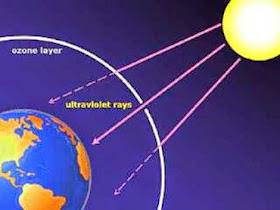You should know that the ozone layer is located at the height from 20 to 40 km above the sea level , And it is located in the lower part of the stratosphere layer , As it is the first layer of the atmospheric envelope which contains a suitable amount of oxygen gas , and it also faces the ultraviolet radiations that emitted from the Sun .
The structure of the ozone layer
 |
| The ozone gas consists of three atoms . |
It is very important to know that the ozone layer is composed of the ozone gas which consists of three oxygen atoms .
The formation of the ozone gas

Each oxygen atom combines with an oxygen forming the ozone molecule .

You should know that the oxygen molecule absorbs the ultraviolet radiation ( UV ) , Which causes the break down of the bond between the two oxygen atoms giving two free oxygen atoms , And each oxygen atom combines with an oxygen molecule forming the ozone molecule which is composed of three oxygen atoms .
 |
| Ozone layer has a faint blue colour and a distinct smell . |
The thickness of the ozone layer
You should know that the value of the atmospheric pressure in the stratosphere layer is 0.001 of the normal atmospheric pressure at the sea level , And the temperature is less than that at the sea level . So , In these conditions , The zone gas forms a layer of a thickness 20 km .
You should know that the English scientist " Dobson " postulated that the thickness of the ozone layer is compressed into 3 mm . Only if it is under the normal atmospheric pressure , and at the zero temperature ( STP ) .
STP means standard temperature , and normal atmospheric pressure .
So , The scientists took " Dobson " as a measuring unit of the degree for the ozone layer . The natural degree of the ozone is 300 Dobson units ( 100 Dobson unit ( DU ) is defined as 1mm thickness ) .
The importance of the ozone layer
 |
| The living organisms are protected from the harmful effects of the ultraviolet radiations by the ozone layer . |
Do you know the types of the UV rays ?
You should know that there are three types of the UV rays which they are different in the wave lengths , and the effects .
Near ultraviolet rays ( UV - A ) .
Medium ultraviolet rays ( UV - B ) .
Far ultraviolet rays ( UV - C ) .
You should know that the ozone layer acts as a protective shield for the living organisms against the harmful chemical effects of the ultraviolet radiations .
100 % of the far ultraviolet rays ( UV - C ) do not penetrate the ozone layer as they are absorbed by the ozone layer .
95 % of the medium ultraviolet rays ( UV - B ) are absorbed by the ozone layer , and do not penetrate it .
100 % of the near ultraviolet rays ( UV - A ) penetrate the ozone layer .
 |
| 100 % of the near ultraviolet rays ( UV - A ) penetrate the ozone layer . |
The harmful effects of the medium and the far ultraviolet rays
When they penetrate the ozone layer they cause the harmful effects for the living organisms as they increase the rate of the skin cancer , They cause the weakness of the immunity system , and they cause a cataract to the human ( It is a disease infects the eye ) .
They spoil the eggs of the amphibians , So , They decrease the rate of the reproduction of them .
They cause the death of the plankton which is the main nutrient of the small marine creatures . And they destroy the marine food chains .
They cause the upset of the photosynthesis process of the terrestrial plants , And they cause the shortage of the crops production .

No comments:
Post a Comment